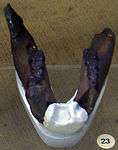Dryopithecus
| Dryopithecus | |
|---|---|
| Mandible fragment of D. fontani from Saint-Gaudens, France (Middle Miocene, 11,5 My) ; cast from Museum national d'histoire naturelle, Paris | |
| Scientific classification | |
| Kingdom: | Animalia |
| Phylum: | Chordata |
| Class: | Mammalia |
| Order: | Primates |
| Superfamily: | Hominoidea |
| Family: | Hominidae |
| Subfamily: | Homininae |
| Tribe: | Dryopithecini |
| Genus: | Dryopithecus† Lartet, 1856 |
| Species | |
| |
Dryopithecus is a genus of extinct apes that is known from Eurasia during the late Miocene period.
Description

Dryopithecus was about 4 feet (1.2 m) long and more closely resembled a monkey than a modern ape. The structure of its limbs and wrists show that it walked in a way similar to modern chimpanzees but that it used the flat of its hands, like a monkey, rather than knuckle-walking like modern apes.[1] Its face exhibited klinorhynchy, i.e. it was tilted downwards in profile.
Biology
Like Sivapithecus, Dryopithecus was suspensory, had a large brain and a delayed development; but, unlike the former, it had a gracile jaw with thinly enameled molars and suspensory forelimbs. The similarities and differences between them provide insight into the timing and paleogeography of hominin origins and the phylogenetic divide between Asian and Afro-European great apes.[2]
It likely spent most of its life in trees, and was probably not a brachiator because it did not have the skeletal adaptations. Its molars had relatively little enamel, suggesting that it ate soft leaves and fruit, an ideal diet for a tree-dwelling animal.[1]
The five-cusp and juvenile[3] fissure pattern of its molar teeth, known as the Y-5 arrangement, is typical of the dryopithecids and of hominoids in general.
Additional images


See also
Notes
- 1 2 Palmer 1999
- ↑ Begun 2004, Abstract, Conclusions
- ↑ Simons & Meinel 1983
References
- Begun, David R. (2004). "Sivapithecus is east and Dryopithecus is west, and never the twain shall meet". Anthropological Science. 113 (1): 53–64. CiteSeerX 10.1.1.88.1617. doi:10.1537/ase.04S008.
- Harrison, Terry; Ribot, F; Gibert, J (1996). "A reinterpretation of the taxonomy of Dryopithecus from Valles-Penedes, Catalonia (Spain)" (PDF). Journal of Human Evolution. 31: 129–141. doi:10.1006/jhev.1996.0054. Terry Harrison's faculty page
- Kordos, László; Begun, David R. (2001). "A new cranium of Dryopithecus from Rudabánya, Hungary" (PDF). Journal of Human Evolution. 41: 689–700. doi:10.1006/jhev.2001.0523.
- Palmer, D, ed. (1999). The Marshall Illustrated Encyclopedia of Dinosaurs and Prehistoric Animals. London: Marshall Editions. p. 292. ISBN 1-84028-152-9.
- Pilbeam, David; Simons, E. L. (February 1971). "Biological Sciences: Humerus of Dryopithecus from Saint Gaudens, France". Nature. 229 (5284): 406–407. doi:10.1038/229406a0. PMID 4926991.
- Simons, E. L.; Meinel, W. (1983). "Mandibular ontogeny in the miocene great apeDryopithecus". International Journal of Primatology. 4 (4): 331–337. doi:10.1007/BF02735598.
- Xue, Xiang-Xu; Delson, Eric (1989). "A new species of Dryopithecus from Gansu, China" (PDF). Chinese Science Bulletin. 34: 223–230.
External links
| Wikimedia Commons has media related to Dryopithecus. |
| Wikispecies has information related to Dryopithecus |